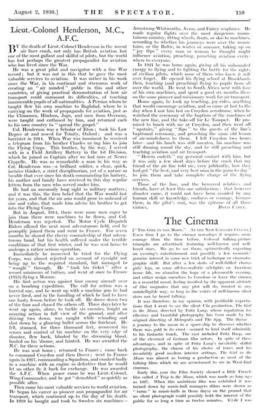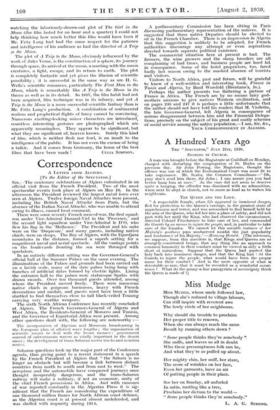The Cinema
EAeir time I go to the cinema nowadays it requires more courage than the time before. Colossal talking-picture triumphs are advertised, featuring well-known and well- loved stars. We go to see them, optimistically expecting an evening's entertainment and possibly a few moments' genuine interest in some new trick of technique or cinemato- graphic skill. But after a few shots of well-drilled chorus girls' legs, or sonic all-too-realistic sidelights on American home life, we abandon the hope of a pleasurable evening, and either resign ourselves to boredom or leave the cinema in a resentful mood, feeling insulted by the apparent altitude of film magnates that any plot will do, treated in any unintelligible way, so long as the voices of well-known silent stars can be heard talking.
It was therefore, in may opinion, with justifiable expecta- tions that I went to see the silent Ufa production, The Girl in the Moon, directed by Fritz Lang, whose reputation for effective and beautiful photography has been made by his original directing of Metropolis and The Spy. The theme a journey to the moon in a space-ship to discover whether there was gold in its crust —seemed to lend itself admirably to his fantastic touch. The cast included Fritz Hasp, 0111' of the cleverest of Cennan film actors. In spite of these advantages, and in spite of Fritz Lang's inevitably skilful photography, the charm of his choice of tones and his invariably good modern interior settings, The Girl in the Moon was almost as boring a production as most of the talking films which we are accustomed to see in West-End cinemas.
Early this year the Film Society showed a little French film called A Trip to the Moon, which was made as long ag as 1897. When this ambitious film was exhibited it was turned down by music-hall managers (films were shown as " turns" in music-halls in those days) on the ground that no silent photograph could possibly hold the interest of the public for so long a time as twelve minutes. While I was watching the laboriously-drawn-out plot of The Girl in the Moon (the film lasted for an hour and a quarter) I could not help thinking how much better this film would have been if Mr. Fritz Lang had had the same respect for the patience and intelligence of his audience as had the director of A Trip to the Moon.
The plot of A Trip to the Moon, obviously influenced by the work of Jules Verne, is the construction of a sphere, its journey through space, its arrival at the moon, a meeting with the moon creatures, a fight, escape, and its return to earth. The plot is completely fantastic and yet gives the illusion of scientific possibility ; it is successful in the same way as are H. G. Wells's scientific romances, particularly The First Man in the Moon, which is remarkably like A Trip to the Moon in its theme as well as in its detail. In 1897, the film habit had not been acquired, film technique was in its infancy, and yet A Trip to the Moon is a more successful scientific fantasy than is Mr. Fritz Lang's production. A combination of sentimental realism and prophetical flights of fancy cannot be convincing. Numerous exciting-looking minor characters are introduced, countless interesting gestures are photographed which are apparently meaningless. They appear to be significant, but what they are significant of, heaven knows. Surely this kind of film, which is neither flesh nor fowl, is an insult to the intelligence of the public. It has not even the excuse of being a talkie. And it comes from Germany, the home of the best

































 Previous page
Previous page